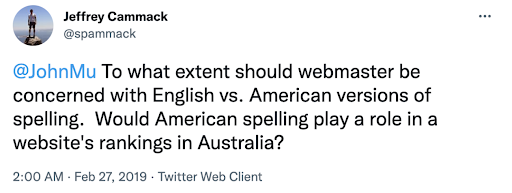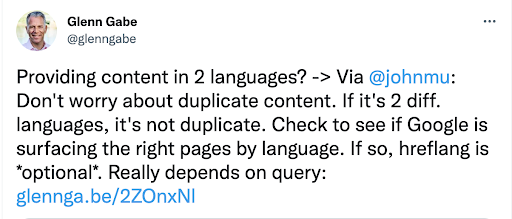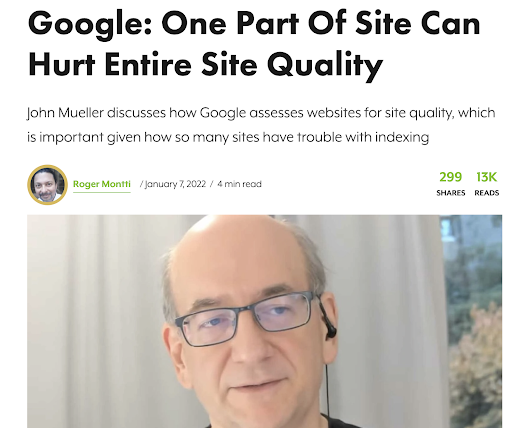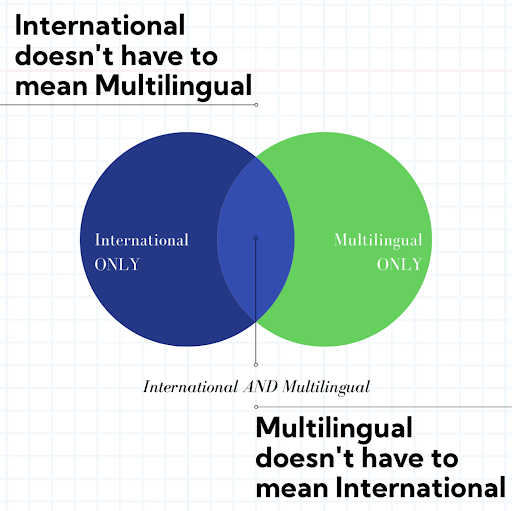International SEO can have its fair share of nuances. Beyond certain technical matters like combating duplicate content and properly utilizing hreflang tags, internationalization often requires in-depth localized research and high-level strategic thinking.
Dialing in your SEO for multi-regional and multilingual audiences starts with addressing the bigger picture behind your business’s international requirements. Considerations like country- and language-specific targeting – as well as cultural differences can have a tremendous influence on a site’s content and tech SEO strategy.
To help sift through a rather dense topic, here we distill a few common issues and assumptions surrounding multi-regional/multilingual SEO, and how teams can better embrace such challenges with the right perspective.
Issue #1: Full or near duplicate content across international page variations
One of the most common issues concerning international SEO is duplicate content. This can result from many scenarios, like aimless (sub)domain/folder setups, erratic language/country targeting, or using hreflang as the end-all-be-all to cover your bases (… it doesn’t!).
Below I break down the common symptoms of full or near-duplicate content involving international SEO, including why it can happen and what you can do to take action. The same breakdown applies to the two issues that follow.
Quickly, before we dig in: Just what counts as “duplicate content” in international SEO?
Identical or nearly identical page copy in the same language, on different URLs, typically targeting different regions, for example:
- French language in Belgium and France
- English language in the US, Canada, and the UK (or anywhere else in the world)
For SEO purposes, UK English and US English are the same thing:


Image source: https://twitter.com/spammack/status/1100651883981623301
Copy that’s translated into a different core language, by definition, is NOT duplicate content – so don’t worry about this situation.

Image source: https://twitter.com/glenngabe/status/1455221270614888451
Symptoms
International duplicate content can take many shapes, often making it a mystery to solve. Here are a few of the most common scenarios that you might see.
- Lack of indexation – Google simply decides not to index your new, international page variations. In GSC this is typically displayed as “Duplicate, submitted URL not selected as canonical.”
- Haphazard indexation – Google haphazardly canonicalizes one variation versus another international variation, often resulting in page de-indexation. It’s typically the newer variation you introduced that’s deindexed because the prior pages are likely to have more internal/external page equity…. but that’s not always the case.
- URLs indexed in the wrong places – Google shows certain country-specific pages in the wrong regions (e.g. /en-ca/ pages indexed in Google.com for users in the US, and /en-us/ pages indexed in Google.ca for users in Canada.)
These are all variations of the same core issue: Google isn’t successfully showing the right pages in the right places.
Why did it happen?
Given the variety of symptoms that can manifest, duplicate content can be somewhat elusive to troubleshoot. The most common reasons why it happens are primarily rooted in the following assumptions.
- Assuming you can just copy your entire site, paste it on a new ccTLD (or cc-subdomain, or cc-subfolder) and have the SEO results magically follow.
- To be super clear here, only fixing a regional-specific spelling (eg “colour” vs “color”) and switching out a word or two (eg “pants” vs “trousers”) still constitutes duplicate content.
- Assuming that Hreflang will solve any and all duplicate content issues. (Surprise – it doesn’t!)
- Assuming that SEO internationalization inherently means language AND region targeting (versus either/or/both).

Image source: Made/owned by Gray Dot Co- Typically, this is due to not properly defining your business requirements for this expansion, and therefore not properly scoping your brand’s SEO requirements for internationalization.
What to do about it?
The bar for unique copy is high, so you’ll want to determine if your business needs:
- language-only targeting,
- region-only targeting, or
- language AND region targeting…
Then structure your site accordingly.
If having same-language targeting in different regions (e.g. en-UK and en-US) is a legal obligation or core business requirement, crafting unique variations is possible, and may even improve sales/conversions.
That said, it’s typically expensive to implement, so make sure you budget for the time/expense needed to do so correctly. Challenged by how exactly you’ll do this? Explore ideas for how you might-reframe copy from a unique strategic angle.
If you don’t, just doing language-only targeting globally is perfectly fine and valid… and frankly, simpler, cheaper and easier to set up & maintain.
Whichever setup is right for you, consider also engaging in localized link building. Building strong local ranking signals will improve performance within your brand’s target region(s) – whether that’s a region-specific URL or a global one!
Issue #2: Low-quality (often automated) translations
Much like a human, Google uses a page’s visible content to determine its language. As such, translating your content for target languages of interest is a common practice to avail your site’s products or services internationally.
While easy and efficient, automated translations don’t always make sense, and according to Google, may be viewed as spam. Artificial-sounding or boilerplate translations can also harm your site’s perception while creating a poor user experience.
Symptom
The most common symptom of low-quality translations is experiencing performance drops for original core pages – or the entire site! – after introducing internationalization elements.
Why did it happen?
While the reasons why this occurs may seem obvious, they often have many overlapping layers, such as:
- Assuming auto-translated copy would cut it.
- Under-budgeting for the necessary work for proper, high-quality translations.
Ultimately, the introduction of multiple low-quality pages can and does impact overall site quality, which can, in turn, impact all your rankings.
 Image source: https://www.searchenginejournal.com/website-quality/432065/
Image source: https://www.searchenginejournal.com/website-quality/432065/
What to do about it?
The remedy is pretty simple: create better translations. Sure, the effort of hiring a qualified translator may seem like a heavy lift or a costly investment. But when entering into new markets that speak different languages, footing the bill for accurate, high-quality translations is a must.
Otherwise you run the risk of jeopardizing your site’s existing performance.
Important caveats
- Like all things SEO, when it comes to multilingual SEO and translations – it depends! Some bigger brands get away with low-quality auto-translations. In most cases, this is because there aren’t better alternative options for Google to rank for a particular country/region instead. But if/when this changes… all bets are off.
- “Perfect” translations are more critical for some site elements compared to others. For instance, core page copy (e.g. the big, prominent, critical copy that’s unique to a page) is the most important to translate sufficiently. Other copy elements (like UGC reviews, for example) may not require this level of effort (especially if scale is a concern!) Quality automatic translations for these sorts of “support” elements are oftentimes more acceptable.
Issue #3: Non-localized page copy (and keyword targeting)
In addition to quality translations, taking measures to localize page copy with proper keyword targeting is a common missed opportunity that results in distasteful experiences that send users fleeing.
Consider this: Spanish in Spain is substantially different from Spanish in Mexico (more so than, say, English in the US vs the UK!)
Not only is the dialect, lingo, and terminology different, but the cultural morals and economics can vary widely by region. We’re talking about two very different audiences, despite language similarities.
As a result, localizing page copy and keyword targeting (even when the language is similar) is a critical component of realizing success with international SEO. When this ball is dropped, the symptoms are typically obvious.
[Case Study] Increase visibility by improving website crawlability for Googlebot
Symptoms
Unlike the issues above, standard SEO metrics like rankings and traffic can still improve when page copy doesn’t fully resonate with users. But not all the time. So, symptoms may include:
- Little-to-no organic traffic increases AND no target-region conversions.
- Organic traffic increases… but little-to-no conversions for the target region.
Why did it happen?
Obviously, there are a lot of things (SEO and otherwise!) that can go wrong here – from the price point to the wrong UVP – but SEO targeting can be a factor.
- Are you simply translating your product names into a new language? That may or may not be what they call that product in that language/region!
- Even if you are properly targeting the right keywords for that product/region, something about your translations could be off-putting, of little value, confusing, or…. even actively insulting.
What to do about it?
Much of the action required to resolve this issue hinges on diligent background research and understanding the true audience behind the region or language.
- Conduct language/region-specific keyword research and understand distinct semantics to include in your copy.
- Research the target country. Talk to real users. Do market research. Make sure your products/services make sense.
- Invest in better translations.
Not limited to technical SEO, there’s clearly a lot that goes into strategizing and growing in new international markets. Not only do search engines need help understanding the content of your pages and who it’s intended for, but the quality of your translations and overall page copy speaks volumes (and that extends well beyond your SEO, too.)


